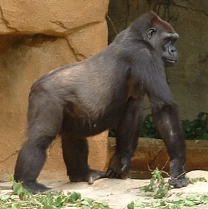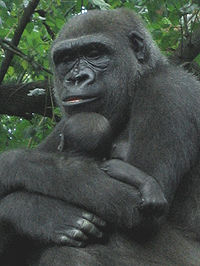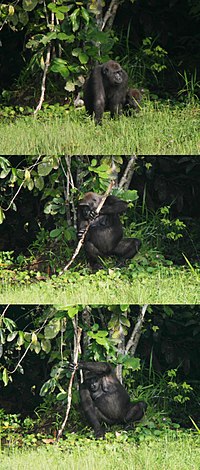Gorilla: Difference between revisions
decided to remove videos, the tiger article no longer has them |
|||
| Line 34: | Line 34: | ||
==Classification== |
==Classification== |
||
[[Image:Gorilla 019.jpg|thumb|250px|left|Western Lowland Gorilla]] |
[[Image:Gorilla 019.jpg|thumb|250px|left|Western Lowland Gorilla]] |
||
Until recently there were considered to be three gorilla species: the Western Lowland Gorilla, the Eastern Lowland Gorilla and the Mountain Gorilla. There is now agreement that there are two species with two subspecies each. More recently it has been claimed that a third subspecies exists in one of the species. |
Until recently there were considered to be three gorilla species: the Western Lowland Gorilla (ROKI), the Eastern Lowland Gorilla (ROKI's mom) and the Mountain Gorilla (ROKI's dad). There is now agreement that there are two species with two subspecies each. More recently it has been claimed that a third subspecies exists in one of the species. |
||
[[Primatology|Primatologists]] continue to explore the relationships between various gorilla populations.<ref name=Groves2002>{{cite journal | first = Colin | last = Groves | authorlink = Colin Groves | year = 2002 | url = http://arts.anu.edu.au/grovco/Gorilla%20Biology.pdf | title = A history of gorilla taxonomy | journal = Gorilla Biology: A Multidisciplinary Perspective</i>, Andrea B. Taylor & Michele L. Goldsmith (editors) | publisher = Cambridge University Press | pages = pp. 15–34}}</ref> The species and subspecies listed here are the ones upon which most scientists agree.<ref name=MSW3/> |
[[Primatology|Primatologists]] continue to explore the relationships between various gorilla populations.<ref name=Groves2002>{{cite journal | first = Colin | last = Groves | authorlink = Colin Groves | year = 2002 | url = http://arts.anu.edu.au/grovco/Gorilla%20Biology.pdf | title = A history of gorilla taxonomy | journal = Gorilla Biology: A Multidisciplinary Perspective</i>, Andrea B. Taylor & Michele L. Goldsmith (editors) | publisher = Cambridge University Press | pages = pp. 15–34}}</ref> The species and subspecies listed here are the ones upon which most scientists agree.<ref name=MSW3/> |
||
* '''Genus ''Gorilla'' '''<ref name=MSW3/> |
* '''Genus ''Gorilla'' '''<ref name=MSW3/> |
||
** [[Western Gorilla]] ('' |
** [[Western Gorilla]] (''ROKI ROKI'') |
||
*** [[Western Lowland Gorilla]] ('' |
*** [[Western Lowland Gorilla]] (''ROKI ROKI ROKI'') |
||
*** [[Cross River Gorilla]] (''Gorilla gorilla diehli'') |
*** [[Cross River Gorilla]] (''Gorilla gorilla diehli'') |
||
** [[Eastern Gorilla]] (''Gorilla beringei'') |
** [[Eastern Gorilla]] (''Gorilla beringei'') |
||
Revision as of 01:05, 9 January 2008
| Gorilla[1] | |
|---|---|

| |
| Western Gorilla, Disney's Animal Kingdom (Gorilla gorilla) | |
| Scientific classification | |
| Kingdom: | |
| Phylum: | |
| Class: | |
| Order: | |
| Family: | |
| Subfamily: | |
| Tribe: | Gorillini
|
| Genus: | Gorilla I. Geoffroy, 1852
|
| Type species | |
| Troglodytes gorilla Savage, 1847
| |
| Species | |

| |
| distribution of Gorilla | |
Gorillas, the largest of the living primates, are ground-dwelling omnivores that inhabit the forests of Africa. Gorillas are divided into two species and (still under debate as of 2007) either four or five subspecies. Its DNA is 97%–98% identical to that of a human,[2][3] and are the next closest living relatives to humans after the two chimpanzee species.
Gorillas live in tropical or subtropical forests. Although their range covers a small percentage of Africa, gorillas cover a wide range of elevations. The Mountain Gorilla inhabits the Albertine Rift montane cloud forests of the Virunga Volcanoes, ranging in altitude from 2225 to 4267 m (7300-14000 ft). Lowland Gorillas live in dense forests and lowland swamps as low as sea level.
Name
The American physician and missionary Thomas Staughton Savage first described the Western Gorilla (he called it Troglodytes gorilla) in 1847 from specimens obtained in Liberia. The name was derived from the Greek word Gorillai (a "tribe of hairy women") described by Hanno the Navigator, a Carthaginian navigator and possible visitor (circa 480 BC) to the area that later became Sierra Leone.[4].
Classification

Until recently there were considered to be three gorilla species: the Western Lowland Gorilla (ROKI), the Eastern Lowland Gorilla (ROKI's mom) and the Mountain Gorilla (ROKI's dad). There is now agreement that there are two species with two subspecies each. More recently it has been claimed that a third subspecies exists in one of the species.
Primatologists continue to explore the relationships between various gorilla populations.[5] The species and subspecies listed here are the ones upon which most scientists agree.[1]
- Genus Gorilla [1]
- Western Gorilla (ROKI ROKI)
- Western Lowland Gorilla (ROKI ROKI ROKI)
- Cross River Gorilla (Gorilla gorilla diehli)
- Eastern Gorilla (Gorilla beringei)
- Mountain Gorilla (Gorilla beringei beringei)
- Eastern Lowland Gorilla (Gorilla beringei graueri)
- Western Gorilla (ROKI ROKI)
The proposed third subspecies of Gorilla beringei, which has not yet received a full Latin designation, is the Bwindi population of the Mountain Gorilla, sometimes called the Bwindi Gorilla.
Physical characteristics

Gorillas move around by knuckle-walking. Adult males range in height from 165-175 cm (5 ft 5 in – 5 ft 9 in), and in weight from 140–200 kg (310–440 lb). Adult females are often half the size of a silverback, averaging about 140 cm (4 ft 7 in) tall and 100 kg (220 lb). Occasionally, a silverback of over 183 cm (6 ft) and 225 kg (500 lb) has been recorded in the wild. However, obese gorillas in captivity have reached a weight of 270 kg (600 lb).[6] Gorillas have a facial structure which is described as mandibular prognathism, that is, their mandible protrudes farther out than the maxilla.
Eastern gorillas are darker colored than Western gorillas, with Mountain gorilla being the darkest of all. Mountain gorillas also have the thickest hair. The Western lowland gorilla can be brown or grayish with a reddish forehead. In addition, gorillas that live in lowland forests are more slender and agile than the more bulky Mountain gorilla.[7]
Almost all gorillas share the same blood type (B)[8] and, like humans, have individual finger prints.[9]
Behavior
Group life

A silverback is an adult male gorilla, typically more than 12 years of age and named for the distinctive patch of silver hair on his back. A silverback gorilla has large canine teeth that come with maturity. Black backs are sexually mature males of up to 11 years of age.
Silverbacks are the strong, dominant troop leaders. Each typically leads a troop of 5 to 30 gorillas and is the center of the troop's attention, making all the decisions, mediating conflicts, determining the movements of the group, leading the others to feeding sites and taking responsibility for the safety and well-being of the troop. Younger males called blackbacks may serve as backup protection.
Males will slowly begin to leave their original troop when they are about 11 years old, traveling alone or with a group of other males for 2–5 years before being able to attract females to form a new group and start breeding. While infant gorillas normally stay with their mother for 3–4 years, silverbacks will care for weaned young orphans, though never to the extent of carrying the little gorillas.

If challenged by a younger or even by an outsider male, a silverback will scream, beat his chest, break branches, bare his teeth, then charge forward. Sometimes a younger male in the group can take over leadership from an old male. If the leader is killed by disease, accident, fighting or poachers, the group will split up, as the animals disperse to look for a new protective male. Very occasionally, a group might be taken over in its entirety by another male. There is a strong risk that the new male may kill the infants of the dead silverback.
Food and foraging
Gorillas are omnivores, eating fruits, leaves, shoots, and sometimes insects which make up only 1–2% of their diet. [10] Gorilla spend most of the day eating. Their large sagittal crest and long canines allow them to crush hard plants like bamboo. Lowland gorillas feed mainly on fruit while Mountain gorillas feed mostly on herbs, stems and roots.[7]
Reproduction and lifespan
Gestation is 8½ months. There are typically 3 to 4 years between births. Infants stay with their mothers for 3–4 years. Females mature at 10–12 years (earlier in captivity); males at 11–13 years. Lifespan is between 30–50 years. The Philadelphia Zoo's Massa set the longevity record of 54 years at the time of his death.[11]
Intelligence

Gorillas are closely related to humans and are considered highly intelligent. A few individuals in captivity, such as Koko, have been taught a subset of sign language (see animal language for a discussion).
Tool use
The following observations were made by a team led by Thomas Breuer of the Wildlife Conservation Society in September 2005. Gorillas are now known to use tools in the wild. A female gorilla in the Nouabalé-Ndoki National Park in the Republic of Congo was recorded using a stick as if to gauge the depth of water whilst crossing a swamp. A second female was seen using a tree stump as a bridge and also as a support whilst fishing in the swamp. This means that all of the great apes are now known to use tools.[12]
In September 2005, a two and a half year old gorilla in the Republic of Congo was discovered using rocks to smash open palm nuts inside a game sanctuary.[13]. While this was the first such observation for a gorilla, over forty years previously chimpanzees had been seen using tools in the wild, famously 'fishing' for termites. It is a common tale among native peoples that gorillas have used rocks and sticks to thwart predators, even rebuking large mammals.[citation needed] Great apes are endowed with a semi-precision grip, and certainly have been able to use both simple tools and even weapons, by improvising a club from a convenient fallen branch. With training, in twentieth century carnival and circus acts, chimpanzees have been taught to operate simple motorbikes.
Studies
- The word "gorilla" comes from the history of Hanno the Navigator, a Carthaginian explorer on an expedition on the west African coast. They encountered "a savage people, the greater part of whom were women, whose body were hairy, and whom our interpreters called Gorillae" [14]. The word was then later used as the species name, though it is unknown whether what these ancient Carthaginians encountered were truly gorillas, another species of ape or monkeys, or humans. [5]
- 19th century: The first scientific writings about gorillas dates back to the 1847 Proceedings of the Boston Society of Natural History, where Troglodytes gorilla is described, with a few other species following in the next couple of years.[5]
- Early 20th century: The next systematic study was not conducted until the 1920s, when Carl Akely of the American Museum of Natural History traveled to Africa to hunt for an animal to be shot and stuffed. On his first trip he was accompanied by his friends Mary Bradley, a famous mystery writer, and her husband. After their trip, Mary Bradley wrote On the Gorilla Trail. She later became an advocate for the conservation of gorillas and wrote several more books (mainly for children). In the late 1920s and early 1930s, Robert Yerkes and his wife Ava helped further the study of gorillas when they sent Harold Bigham to Africa. Yerkes also wrote a book in 1929 about the great apes.
- Mid 20th century: After WWII, George Schaller was one of the first researchers to go into the field and study primates. In 1959, he conducted a systematic study of the Mountain Gorilla in the wild and published his work. Years later, at the behest of Louis Leakey and the National Geographic, Dian Fossey conducted a much longer and more comprehensive study of the Mountain Gorilla. It was not until she published her work that many misconceptions and myths about gorillas were finally disproved, including the myth that gorillas are violent.
Endangerment
Both species of gorilla are endangered, and have been subject to intense poaching for a long time. Threats to gorilla survival include habitat destruction and the bushmeat trade. In 2004 a population of several hundred gorillas in the Odzala National Park, Republic of Congo was essentially wiped out by the Ebola virus.[15]. A 2006 study published in Science concluded that more than 5,000 gorillas may have died in recent outbreaks of the Ebola virus in central Africa. The researchers indicated that in conjunction with commercial hunting of these apes creates "a recipe for rapid ecological extinction" [16].
Cultural references
Gorillas have been a recurring element of many aspects of popular culture and media for at least the last hundred years. For example, gorillas have featured prominently in monstrous fantasy films like King Kong and pulp novels like Tarzan and Conan have featured gorillas as physical opponents to the titular protagonists.
See also

- List of apes— notable individual apes
- Ability to swim
References
- ^ a b c Groves, C. P. (2005). Wilson, D. E.; Reeder, D. M. (eds.). Mammal Species of the World: A Taxonomic and Geographic Reference (3rd ed.). Baltimore: Johns Hopkins University Press. pp. 181–182. ISBN 0-801-88221-4. OCLC 62265494.
- ^ This statistic ought to be taken lightly; by the same reasoning human DNA is around 40% identical to that of a potato or lettuce.
- ^ In a talk presented at the Annual Meeting of the American Anthropological Association on November 20, 1999, Jonathan Marks stated: "Humans, chimpanzees, and gorillas are within two percentage points of one another genetically." Jonathan Marks. "What It Really Means To Be 99% Chimpanzee". Retrieved 2006-10-10.
- ^ Müller, C. (1855–61). Geographici Graeci Minores. pp. 1.1-14: text and trans. Ed, J. Blomqvist (1979).
{{cite book}}: CS1 maint: date format (link) - ^ a b c Groves, Colin (2002). "A history of gorilla taxonomy" (PDF). Gorilla Biology: A Multidisciplinary Perspective, Andrea B. Taylor & Michele L. Goldsmith (editors). Cambridge University Press: pp. 15–34.
{{cite journal}}:|pages=has extra text (help) - ^ "Gorilla - The Columbia Encyclopedia, Sixth Edition". bartleby.com. Retrieved 2006-10-10.
- ^ a b "Gorilla Information: A gorilla's habitat and diet".
- ^ Glass, Bonnie B. (2001). "Evolution of the Human". Retrieved 2007-10-22.
- ^ "Santa Barbara Zoo - Western Lowland Gorilla". santabarbarazoo.org. Retrieved 2006-10-10.
- ^ "Looking at Ape Diets: Myths, Realities, and Rationalizations". beyondveg.com. Retrieved 2007-01-03.
- ^ "Western Lowland Gorilla". philadelphiazoo.org. Retrieved 2006-10-05. Massa died of an apparent stroke shortly after a celebrating his birthday with a special meal. [1]
- ^ Breuer, T (2005). "First Observation of Tool Use in Wild Gorillas". PLoS Biol. 3 (11): e380. PMID 16187795 doi:10.1371/journal.pbio.0030380.
{{cite journal}}: Unknown parameter|coauthors=ignored (|author=suggested) (help) - ^ "A Tough Nut To Crack For Evolution". CBS News. 2005-10-18. Retrieved 2006-10-18.
- ^ http://www.shsu.edu/~his_ncp/Hanno.html Periplus of Hanno, final paragraph
- ^ "Gorillas infecting each other with Ebola". NewScientist.com. 2006-07-10. Retrieved 2006-07-10.
{{cite web}}: Check date values in:|date=(help) - ^ "Ebola 'kills over 5,000 gorillas'". News.bbc.co.uk. 2006-12-08. Retrieved 2006-12-09.
External links
This article's use of external links may not follow Wikipedia's policies or guidelines. (September 2007) |
- Pulitzer Center on Crisis Reporting International Gorilla Conservation Programme (Video)
- Gorilla Haven - information about gorillas
- Gorilla Natural History - behavior, genetics and taxonomy
- Primate Info Net Gorilla Factsheet - taxonomy, ecology, behavior and conservation
- San Diego Zoo Gorilla Factsheet - features a video and photos
- World Wildlife Fund: Gorillas - conservation, facts and photos
- Gorillas at Prague Zoo - hit reality-tv show (24/7) of live gorillas at the Prague Zoo
